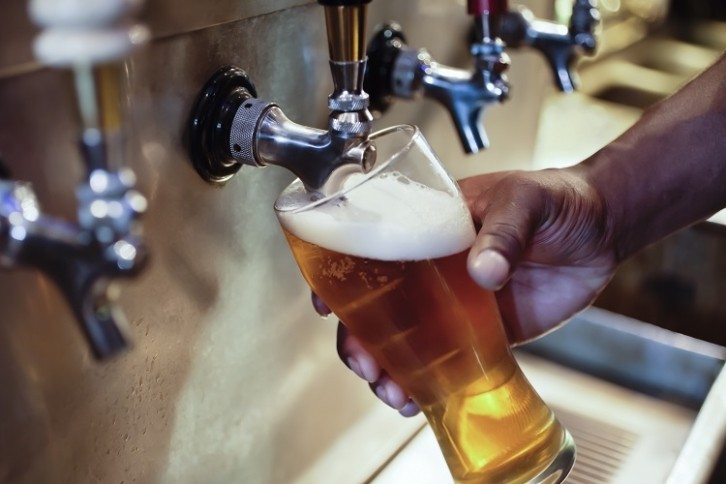What are the risks of non-alcoholic beer on tap?

In increased quantities, alcohol can act as a cleaning agent. This means that it is often, when not being consumed, a component of cleaning products such as hand wipes and hand sanitiser.
When beer is sold on draught in a pub or bar, the alcohol provides certain antimicrobial properties that protect it from contamination.
Non-alcoholic beer, however, does not have this level of protection, and therefore faces challenges that alcoholic beer does not.
What hygiene challenges does non-alcoholic beer face?
At a mere 0% to 0.5% ABV, non-alcoholic beer misses the threshold for having that protective effect that ethanol provides in alcoholic beer, which is usually 4 to 6% ABV.
“Challenges can relate to physical flavour instability (non-microbiological) and susceptibility to microbiological contamination if not well managed. Non-alcoholic beer usually has a lower bitterness, as the matrix of the beer is much ‘thinner’ and will allow less hops to taste bitter compared to stronger beers. Hops provide a protective effect against bacterial reproduction - a mild so-called bacteriostatic effect,” Simon Spillane, head of operation at the organisation Brewers of Europe, told FoodNavigator. A bacteriostatic effect is when an agent prevents the growth of bacteria.
How can you ensure non-alcoholic beer is safe to consume?
Is there stigma around non-alcoholic beer?
Social stigma exists for drinking non-alcoholic beer, but at different levels in different markets. For example, data from Mintel shows that in 2017, only 9% of Germans were embarrassed about drinking non-alcoholic beer. In other markets, where non-alcoholic beer is less well established, it may be higher.
According to ABInbev, the world’s biggest brewery, providing people with non-alcoholic versions of familiar brands is one way of getting over this stigma.
Safety can be ensured, however. One must, Spillane told us, pay attention to the freshness of the beer. The sooner after it’s left the brewery, the better.
Secondly, it must be kept in cold storage between production and consumption. It must also be dispensed in an aseptic or bacteriostatic way via systems that can be efficiently cleaned and sanitised, or through one-way dispense lines (a system designed so that the beer flows in only one direction – from beer to tap).
Finally, non-alcoholic beer on draught must be consumed as quickly as possible after the keg is broached.
And what about soft drinks, which also lack alcohol? While they do, they are also less ‘delicate’, Spillane told us, and less resistant than non-alcoholic beer.
“Non-alcoholic beer is pasteurised but usually much less so than sugary soft drinks, as this would result in ‘cooked’ flavours coming through. [It] is a delicate and subtle product so therefore less resistant and rugged. [It] also has much less fermentable sugars compared with a sugary soft drink, and is considerably less acidic than most soft drinks (acidity has an antibacterial effect).”

Is the European non-alcoholic beer market expanding?
Non-alcoholic beer, according to Spillane, is getting more and more popular in Europe. According to an estimation by Brewers of Europe, every fifteenth beer sold in the EU is now non-alcoholic, and over the last decade, the market has doubled, now representing 6% of the EU beer market.
According to Spillane, as non-alcoholic beer became more popular, kegs were emptied more quickly and thus spent less time in the keg after it was broached.
“This evolved as the market grew and with reference to some of the points elaborated above on the need for the beer to be handled sensitively and also consumed quickly once brewed and the keg has been broached in the bar.”
Marketing alcohol-free responsibly
Do non-alcoholic drinks provide a gateway for children to start drinking alcohol? Responsible marketing is vital to avoid this potential.
Non-alcoholic marketing, said the UK’s Portman Group, should be targeted squarely at adults, and not include anyone who looks under 25. Plus, advertising showing people driving, playing sport, or otherwise engaging in risky activities should make it very clear they’ve consumed an alcohol alternative, rather than alcohol. Finally, it should be communicated when there are trace amounts of alcohol in a product.
Sales of non-alcoholic beer have grown significantly in the UK as well, going from 1.5% of the beer market in January 2020 to 2.7% in December 2023, according to market research company Circana.
At a recent event focusing on non-alcoholic beer, FoodNavigator heard that the non-alcoholic beer industry strives to be able to sell non-alcoholic beer on tap, as without a label this allows consumers to drink it without anyone knowing it’s alcohol-free, and therefore avoid any perceived stigma (see panel).
Furthermore, research last year showed that alcohol is mentioned in fewer chart-topping hits than it once was.








